定价竞争策略英文
marketing plan范文
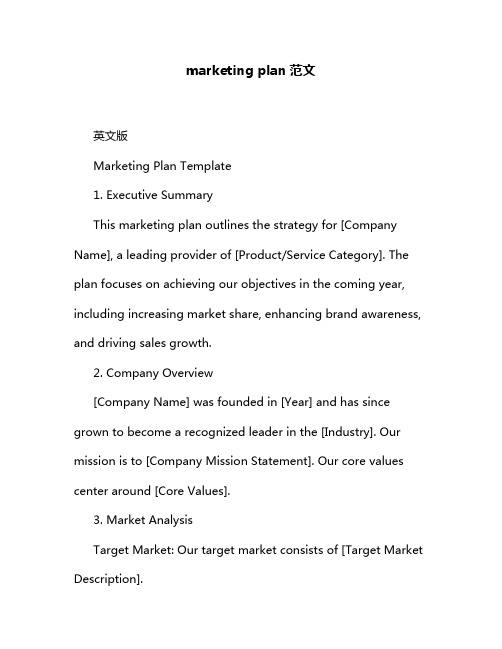
marketing plan范文英文版Marketing Plan Template1. Executive SummaryThis marketing plan outlines the strategy for [Company Name], a leading provider of [Product/Service Category]. The plan focuses on achieving our objectives in the coming year, including increasing market share, enhancing brand awareness, and driving sales growth.2. Company Overview[Company Name] was founded in [Year] and has since grown to become a recognized leader in the [Industry]. Our mission is to [Company Mission Statement]. Our core values center around [Core Values].3. Market AnalysisTarget Market: Our target market consists of [Target Market Description].Competition: Our main competitors are [List of Competitors].Market Trends: [Current Market Trends].4. Marketing ObjectivesIncrease market share by [Percentage] by the end of the year.Achieve a [Percentage] increase in brand awareness.Drive sales growth by [Percentage] over the next 12 months.5. Marketing StrategyPositioning: We position ourselves as the [Positioning Statement].Product/Service Strategy: We will [Product/Service Strategy].Pricing Strategy: Our pricing will be [Pricing Strategy].Promotion Strategy: We plan to [Promotion Strategy].Place Strategy: We will distribute our products/services through [Distribution Channels].6. Marketing TacticsAdvertising: We will advertise on [Advertising Platforms].Social Media Marketing: We plan to engage with customers on [Social Media Platforms].Content Marketing: We will create and distribute [Types of Content].Email Marketing: We will send targeted emails to [Target Audience].7. Financial ConsiderationsBudget: Our marketing budget for the year is [Budget Amount].Expected ROI: We expect a return on investment of [Expected ROI Percentage].8. Evaluation and AdjustmentsWe will regularly evaluate our marketing efforts and make adjustments as necessary to ensure we are meeting our objectives. We will track key performance indicators (KPIs) and use data to inform our decisions.中文版市场营销计划范文1. 摘要本市场营销计划概述了[公司名称]的战略,该公司是[产品/服务类别]领域的领先供应商。
定价策略的名词解释
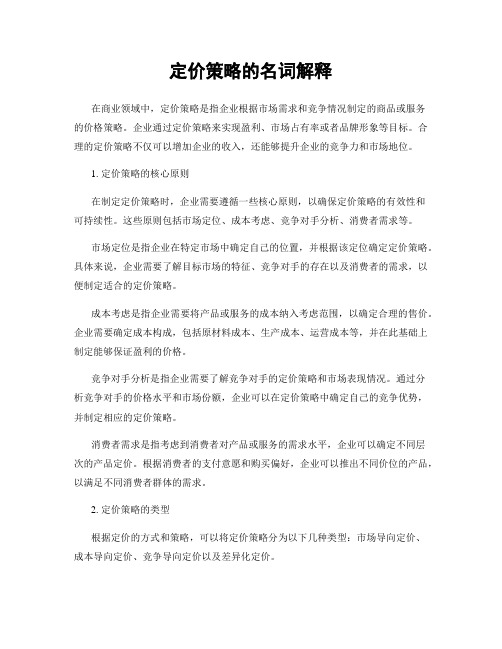
定价策略的名词解释在商业领域中,定价策略是指企业根据市场需求和竞争情况制定的商品或服务的价格策略。
企业通过定价策略来实现盈利、市场占有率或者品牌形象等目标。
合理的定价策略不仅可以增加企业的收入,还能够提升企业的竞争力和市场地位。
1. 定价策略的核心原则在制定定价策略时,企业需要遵循一些核心原则,以确保定价策略的有效性和可持续性。
这些原则包括市场定位、成本考虑、竞争对手分析、消费者需求等。
市场定位是指企业在特定市场中确定自己的位置,并根据该定位确定定价策略。
具体来说,企业需要了解目标市场的特征、竞争对手的存在以及消费者的需求,以便制定适合的定价策略。
成本考虑是指企业需要将产品或服务的成本纳入考虑范围,以确定合理的售价。
企业需要确定成本构成,包括原材料成本、生产成本、运营成本等,并在此基础上制定能够保证盈利的价格。
竞争对手分析是指企业需要了解竞争对手的定价策略和市场表现情况。
通过分析竞争对手的价格水平和市场份额,企业可以在定价策略中确定自己的竞争优势,并制定相应的定价策略。
消费者需求是指考虑到消费者对产品或服务的需求水平,企业可以确定不同层次的产品定价。
根据消费者的支付意愿和购买偏好,企业可以推出不同价位的产品,以满足不同消费者群体的需求。
2. 定价策略的类型根据定价的方式和策略,可以将定价策略分为以下几种类型:市场导向定价、成本导向定价、竞争导向定价以及差异化定价。
市场导向定价是指企业根据市场需求和消费者偏好来设定价格。
当市场需求高涨时,企业可以适当提高价格以获取更多的收益;相反,当市场竞争激烈时,企业可以降低价格以获得更多的市场份额。
成本导向定价是指企业根据产品或服务的成本来制定价格。
这种定价策略依赖于成本分析,以确保产品或服务的成本得到合理补偿。
成本导向定价也可以用来确保企业的盈利能力。
竞争导向定价是指企业根据竞争对手的价格水平来设定价格。
当市场中存在多个竞争对手时,企业可以通过设定与竞争对手相近或略低的价格来吸引消费者。
定价与竞争策略
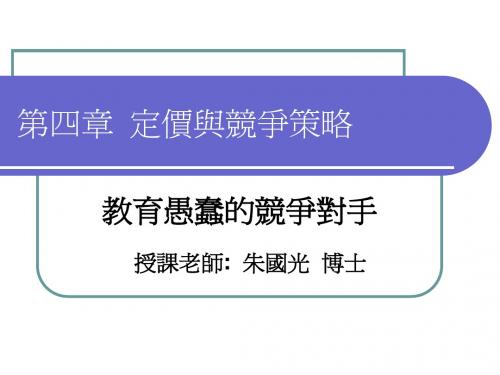
「管理」競爭者和產業利潤
3.「朔造」競爭者反應 三大要素: 1.行動 2.競爭者對行動的看法 3.對這些行動的推論 4. 建立能量庫 分為以下四種層面 1.產品差異化 2.成本定位 3.競爭資訊 4.廣大的市場參與度
「管理」競爭者和產業利潤
1.產品差異化---a.由技術的表現、附加價值的特點 (服務)、品牌的地位來達到目的。 b.顧客對產品價值認知與偏好,是捕 捉「市場盈餘」的基礎。
瞭解並引導競爭對手
以下有幾點不同層面的因素可以來分析價格戰產生的原因: 供應面的因素 需求面的因素
1. 成本結構 2. 設備使用率 3. 產品保存性 4.產品差異程度 5.競爭者的數目和多元性
1. 特定需求的價格敏感性 2. 比價效率 3. 品牌忠誠度 4. 產業成長率 5. 主事者缺乏私人情誼
無罪開釋 巨額利潤 短期徒刑 蠅頭小利
小筆罰金 合理利潤 長期徒刑 沒賺錢
囚犯的兩難問題
堅 守 價 格 降 價 1. F:合理利潤 T:合理利潤 3. F:巨額利潤 T:沒賺錢 堅守價格
泰德(T)
表(二) : 商人的命運矩陣
2. F:沒賺錢 T:巨額利潤 4. F:蠅頭小利 T:蠅頭小利 降價
定價對於競爭定位的衝擊
逆思考的決策過程 ---- 一般的行動順序為 產品設計 成本 定價 市場定位 而逆思考則是完全倒過來,所設定的市場定位顯示其價格幅 度,再進而決定可接受的成本水準,因此限定了設計決策。 不同等級的競爭傾向於「向上消費」的消費行為 ---- 見圖(三) 1. 同一個價格等級內的競爭程度,要比不同等級的競爭更 為激烈。 2. 不同等級的競爭情況是不對稱的。等級較高的產品若調降 價格,較容易吸引原來購買等級較低產品的消費者; 反 之,品質較差的產品若是降價,卻不容易吸引原來購買 品質較高產品的消費者。
赢在微店英语作文电子版
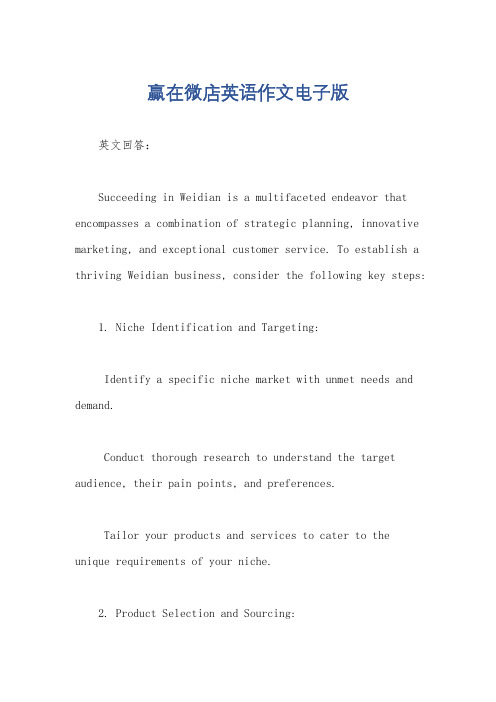
赢在微店英语作文电子版英文回答:Succeeding in Weidian is a multifaceted endeavor that encompasses a combination of strategic planning, innovative marketing, and exceptional customer service. To establish a thriving Weidian business, consider the following key steps:1. Niche Identification and Targeting:Identify a specific niche market with unmet needs and demand.Conduct thorough research to understand the target audience, their pain points, and preferences.Tailor your products and services to cater to the unique requirements of your niche.2. Product Selection and Sourcing:Offer high-quality products that align with the needs of your target market.Establish partnerships with reliable suppliers to ensure product availability and competitive pricing.Continuously expand and optimize your product range based on customer feedback and market trends.3. Competitive Pricing Strategy:Conduct market research to determine optimal pricing for your products and services.Offer competitive prices while maintaining a reasonable profit margin.Consider offering promotions, discounts, and loyalty programs to attract and retain customers.4. Effective Marketing and Promotion:Utilize Weidian's marketing tools, such as live streaming, flash sales, and social media integration.Run targeted advertising campaigns on platforms frequented by your target audience.Collaborate with influencers and brand ambassadors to promote your products and build credibility.5. Customer-Centric Approach:Provide excellent customer service to build long-term relationships.Respond promptly to inquiries, resolve complaints efficiently, and offer personalized assistance.Gather customer feedback and use it to improve product offerings and overall user experience.6. Data Analysis and Optimization:Track your performance metrics to identify areas for improvement.Use data analysis to optimize your marketing campaigns, product selection, and customer service strategies.Regularly review and update your business plan basedon data-driven insights.中文回答:成功经营微店的方法。
定价与竞争策略

定价与竞争策略定价与竞争策略是企业在市场上取得竞争优势的重要手段。
通过合理的定价策略和差异化竞争策略,企业可以在激烈的市场竞争中获得更多的市场份额和利润。
首先,定价策略是企业在市场上确定产品价格的决策。
企业可以采用不同的定价策略来应对市场变化和竞争压力。
常见的定价策略包括市场导向定价、成本导向定价和竞争导向定价。
市场导向定价是指企业根据市场需求和竞争状况来确定产品价格。
企业可以通过市场调研和分析了解市场需求和竞争对手的定价策略,从而合理定价以满足消费者需求并保持竞争力。
成本导向定价是指企业根据产品的生产成本和利润预期来确定产品价格。
企业需要在生产成本和利润之间找到平衡点,使产品价格既能覆盖成本,又能获得合理的利润。
竞争导向定价是指企业根据竞争对手的定价策略来制定自己的定价策略。
企业可以选择与竞争对手价格相当或略高,以示产品的高品质或独特性;也可以选择低价策略,以吸引更多的消费者。
除了定价策略,企业还可以采用差异化竞争策略来增强市场竞争力。
差异化竞争策略是指企业通过产品特性、品牌形象、服务质量等方面与竞争对手进行差异化,以赢得消费者的青睐。
差异化竞争策略可以通过产品设计、功能升级、服务创新等方式实施。
企业可以通过研发创新、技术改进等手段提升产品质量和性能,从而不断满足消费者的需求并留住消费者。
同时,企业还可以通过品牌建设和营销推广来塑造自己的品牌形象。
一个有强大品牌形象的企业往往能够赢得消费者的认同和信任,从而提高产品的市场竞争力。
此外,企业还可以通过提供优质的售后服务来增强市场竞争力。
优质的售后服务能够让消费者感受到企业的关怀和贴心,提高消费者的忠诚度和口碑。
综上所述,定价与竞争策略是企业在市场上取得竞争优势的重要手段。
企业需要根据市场需求、竞争对手、成本和利润等因素来制定合理的定价策略,并通过差异化竞争策略来增强市场竞争力,从而在激烈的市场竞争中取得成功。
企业在制定定价与竞争策略时,需要充分考虑市场变化、消费者需求和竞争对手的举措。
产品策略定价策略渠道策略
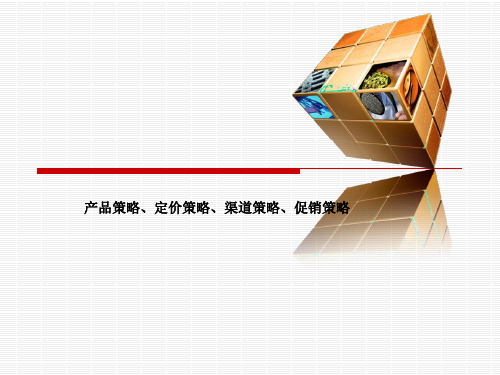
第10章 产品策略
产品是指能提供给市场,用于满足人们某种欲望和需要的任何事物。
教材:P159
主要内容: 产品特色策略、 产品组合策略、 产品生命周期策略、 新产品开发策略
产品只有通过交换实现其价值,才能满足消费者需求。 所以产品一定要到达消费者手中,被消费。 而这个过程要通过合理的营销策略来实现
品牌策略
企业如将某品牌(Brand)在政府有关主管部门注册登记以后,即 成为商标(Trademark)。
品牌附有消费者感情因素
品牌的内涵
属性
角色
利益
品牌
个性
价值
文化
酷儿:角色营销魅力四射
2002年的果汁饮料大战中,表现最抢眼的品牌非可口可乐旗下的“酷儿”
莫属。“酷儿”在众多竞争对手中胜出,在中国区推出时间不足一年,迅速跃
升至果汁市场的前三位置,广州、上海、北京等城市均出现一股“酷儿”热潮,
销量呈倍数增长。
可口可乐这次成功的秘诀是成功的角色营销策略,用扮像可爱的“Qoo酷
儿”角色来拉近商品与消费者之间的距离。
酷儿:角色营销魅力四射
“酷儿”在中国市场,细分的目标群体是6-14岁的儿童,此举跳出大部分果汁品牌针对女性市场的人群 定位,也为“Qoo酷儿”角色的引入创造了条件。“酷儿”博得了小孩子的喜爱,成为他们指定购买 的果汁品牌。针对直接购买者的家长,可口可乐公司还通过理性诉求强调功能利益点:果汁里添加了 维生素C及钙,这无疑给注重孩子健康的父母们吃了定心丸。酷儿果汁由此走红。顶着大大的脑袋, 右手插着腰、左手拿着果汁饮料,陶醉地说着“Qoo……”的蓝色娃娃在广告和终端活动的推广下,成 了家喻户晓的名人,更成为儿童最喜欢的卡通人物。
银行中间业务收费应注意的问题及建议
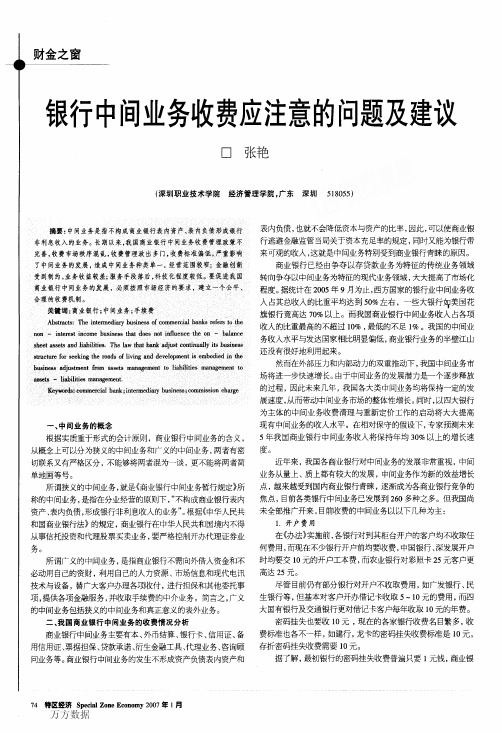
一财金之窗1银行中间业务收费应注意的问题及建口张艳荚键谓:商避银行;中闻鎏务;等爨雾jj旗银行竟高达70%以上。
而我国商业银行中间业1凡/\协J卜LJ王月XI口JHJI7I、K.邕^.土…u,月XlW~bJ,l、^[1,u,th,e收入的14比重最高的不超过10%,最低I-1non--interestincomebusinessthatdoesinfluentheon-balancesheetassetsandliabilities.Thelawthatbankadjustntinuallyitsbusiness篡蒗著簇寿五辜i甭霾柔_…一……“”””一““。
一js删…I二E_./l口I。
止/J州I。
,口l。
制/JuJ7H皇]止刨1eembodiedinthebusinessadjustmentfrommanagementliabiitiesmanagementto|:}l_≯i杂淌薅;舀m面菇ialba酞;i。
termediarybusi薅文commissioneharge的过程,因此未来几年,我国各大类中间业务均将74特区经济SpecialZoneEconomy2007年1月 万方数据行自主确定银行服务收费以后,各商业银行分别确定自己的收费标准,相互之间差别比较大。
2.小额账户费用建行现已将对小额账户收费的试点由深圳扩大到四川,此举意味着建行有可能在全国铺开对小额账户的收费。
而招行更明确将在全国开始对日均金融资产余额低于1万元的账户按月收取管理费1元,目前已在青岛、深圳等地推行,其它地区等收费标准明确后也将收费。
目前建行、招行、中行先行收费,工商银行将于6月21日起对日均存款余额不足300元(不含)的人民币小额个人活期存款账户收取每季3元的服务费。
此举表明,小额账户收费很可能向借记卡收取10元年费一样迅速在各银行实施。
3.存、取款业务从2004年3月1日起,各家银行开始自行决定银行卡同城跨行取款收费标准。
4ps营销理论
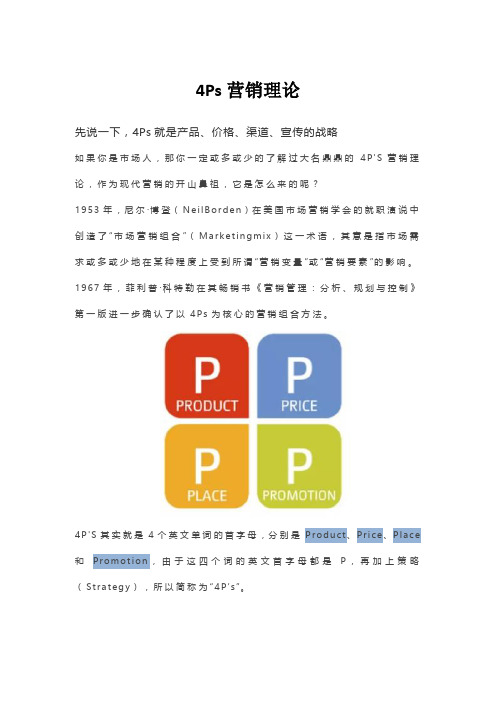
4Ps营销理论先说一下,4Ps就是产品、价格、渠道、宣传的战略如果你是市场人,那你一定或多或少的了解过大名鼎鼎的4P'S营销理论,作为现代营销的开山鼻祖,它是怎么来的呢?1953年,尼尔·博登(N e i l B o r d e n)在美国市场营销学会的就职演说中创造了“市场营销组合”(M a r k e t i n g m i x)这一术语,其意是指市场需求或多或少地在某种程度上受到所谓“营销变量”或“营销要素”的影响。
1967年,菲利普·科特勒在其畅销书《营销管理:分析、规划与控制》第一版进一步确认了以4P s为核心的营销组合方法。
4P'S其实就是4个英文单词的首字母,分别是P r o d u c t、P r i c e、P l a c e 和P r o m o t i o n,由于这四个词的英文首字母都是P,再加上策略(S t r a t e g y),所以简称为“4P’s”。
以下,我们详细了解下4P'S营销的逻辑。
PART1产品(Product)简单讲产品就是指能满足用户欲望或需要的任何东西,它可以是有形产品、人员、组织又或是一种观念。
产品层次理论核心产品层,指商品能够提供给消费者的效用或利益。
比如抖音短视频就是满足消费者年轻心态的一种产品。
有形产品层,指产品的实际情况,比如包装、品牌、质量、样式和特色等。
附加产品层,指购买产品后提供的附加价值,比如买一件商品可以包送货、安装、维修等。
产品营销生命周期每一款产品都会经历4个周期,分别是介绍期、成长期、成熟期和衰退期,每个周期都有不同的特点。
介绍期:产品刚刚推出市场,销售量低、增长缓慢,产品技术性能不完善、价格难以确定、分销渠道尚未建立、促销费用高、利润少甚至亏损。
成长期:产品已经被市场所接受、销售额攀升、促销成本被分摊、产品技术成熟、渠道已建立、成本下降、利润增加、价格趋降、竞争日益激烈。
成熟期:产品开始盈利、营销投入扩大、产品价格降低、销售增长率下降、利润增长缓慢、行业生产能力过剩,竞争白热化。
- 1、下载文档前请自行甄别文档内容的完整性,平台不提供额外的编辑、内容补充、找答案等附加服务。
- 2、"仅部分预览"的文档,不可在线预览部分如存在完整性等问题,可反馈申请退款(可完整预览的文档不适用该条件!)。
- 3、如文档侵犯您的权益,请联系客服反馈,我们会尽快为您处理(人工客服工作时间:9:00-18:30)。
E(Pn(T)) = n(2-1) Var (Pn(T)) = 4n(-1) 2
We wish to obtain a continuous time version of the random walk, we should expect the mean and variance of the limiting process P(T) to be linear in T. Therefore, we must have
Lecture #9: Black-Scholes option pricing formula
• Brownian Motion
The first formal mathematical model of financial asset prices, developed by Bachelier (1900), was the continuous-time random walk, or Brownian motion. This continuous-time process is closely related to the discrete-time versions of the random walk.
Pn(t) = P[t/h] = P[nt/T] , t [0, T], where [x] denotes the greatest integer less than or equal to x. Pn(t) is a left continuous step function.
We need to adjust , such that Pn(t) will converge when n goes to infinity. Consider
3. The sample paths of P(t) are continuous. P(t) is called arithmetic Brownian motion or Winner process.
If we set =0, =1, we obtain standard Brownian Motion which is denoted as B(t). Accordingly, P(t) = t + B(t)
(althrough dB(t) is).
the derivative of Brownian motion, B’(t) does not exist in the ordinary sense, they are nowhere differentiable.
• Stochastic differential
equations
Despite the fact, the infinitesimal increment of Brownian motion, the limit of B(t+h) = B(t) as h approaches to an infinitesimal of time (dt) has earned the notation dB(t) and it has become a fundamental building block for constructing other continuous time process. It is called white noise. For P(t) define earlier we have dP(t) = dt + dB(t). This is called stochastic differential equation. The natural transformation dP(t)/dt = + dB(t)/dt doesn’t male sense because dB(t)/dt is a not well defined
1. For any t1 and t2 such that 0 t1 < t2 T: P(t1)-P(t2) ((t2-t1), 2(t2-t1))
2. For any t1, t 2 , t3, and t4 such that 0 t1 < t2 t1 < t2 t3 < t4 T, the increment P(t2)- P(t1) is statistically independent of the increment P(t4)- P(t3).
• The discrete-time random
walk
Pk = Pk-1 + k, k = (-) with probability (1), P0 is fixed. Consider the following continuous time process Pn(t), t [0, T], which is constructed from the discrete time process Pk, k=1,..n as follows: Let h=T/n and define the process
n(2-1) T 4n(-1) 2 T
This can be accomplished by setting
= ½*(1+h /), =h
• The continuous time limit
It cab be shown that the process P(t) has the following three properties:
Consider the following moments:
E[P(t) | P(t0)] = P(t0) +(t-t0) Var[P(t) | P(t0)] = 2(t-t0) CoSince Var[ (B(t+h)-B(t))/h ] = 2/h, therefore,
